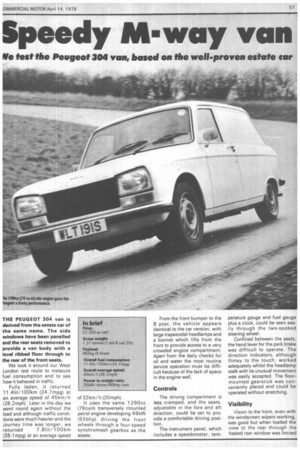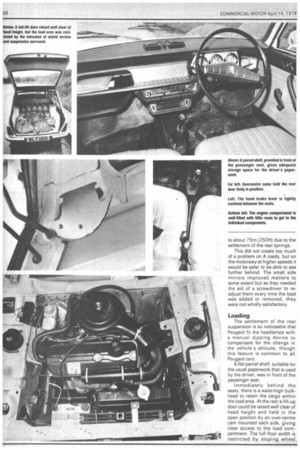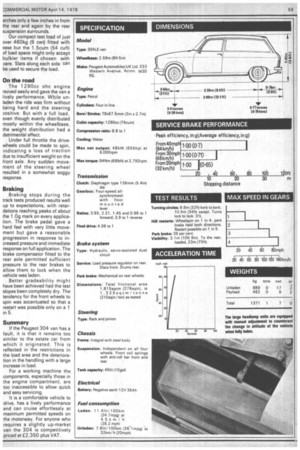Speedy M-way van
Page 59

Page 60

Page 61

If you've noticed an error in this article please click here to report it so we can fix it.
Ate test the Peugeot 304 van, based on the well-proven estate car
THE PEUGEOT 304 van is derived from the estate car of the same name. The side windows have been panelled and the rear seats removed to provide a van body with a level ribbed floor through to the rear of the front seats.
We took it around our West London test route to measure fuel consumption and to see how it behaved in traffic.
Fully laden, it returned 11.41it/ 100km (24.7mpg) at an average speed of 45km/ h (28.2mph). Later in the day we went round again without the load and although traffic conditions were much heavier and the journey time was longer, we returned 7 .81it/ 100km (36.1 mpg) at an average speed of 32km/ h (20mph).
It uses the same 1290cc (79cuin) transversely mounted petrol engine developing 49kW (65bhp) driving the front wheels through a four-speed synchromesh gearbox as the estate.
From the front bumper to the 13 post, the vehicle appears identical to the car version, with large trapezoidal headlamps and a bonnet which lifts from the front to provide access to a very crowded engine compartment. Apart from the daily checks for oil and water the most routine service operation must be difficult because of the lack of space in the engine well.
Controls The driving compartment is less. cramped, and the seats, adjustable in the fore and aft direction, could be set to provide a comfortable driving position.
The instrument panel, which includes a speedometer, tem
perature gauge and fuel gauge plus a clock, could be seen easily through the two-spoked steering wheel.
Confined between the seats, the hand lever for the park brake was difficult to operate. The direction indicators, although flimsy to the touch, worked adequately whilst the headlamp stalk with its unusual movement was easily accepted. The floormounted gearstick was conveniently placed and could be operated without stretching.
Visibility
Vision to the front, even with the windscreen wipers working, was good but when loaded the view to the rear through the heated rear window was limited to about 75m 250ft) due to the settlement of the rear springs.
This did not create too much of a problem on A roads, but on the motorway at higher speeds it would be safer to be able to see further behind. The small side mirrors improved matters to some extent but as they needed the aid of a screwdriver to readjust them every time the load was added or removed, they were not wholly satisfactory.
Loading
The settlement of the rear suspension is so noticeable that Peugeot fit the headlamps with a manual dipping device to compensate for the change in the vehicle's attitude, though this feature is common to all Peugeot cars.
A flat parcel shelf, suitable for the usual paperwork that is used by the driver, was in front of the passenger seat.
Immediately behind the seats, there is a waist-high bulkhead to retain the cargo within the load area. At the rear a lift-up door could be raised wel! clear of head height and held in the open position by an over-centre cam mounted each side, giving clear access to the load compartment. The full floor width is restricted by sloping wheel arches only a few inches in from the rear and again by the rear suspension surrounds.
Our compact test load of just over 460kg (9 cwt) fitted with ease but the 1 .5cum (54 cuft) of load space might only accept bulkier items if chosen with care. Slats along each side can be used to secure the load.
On the road
The 1 290cc ohc engine revved easily and gave the van a lively performance. While unladen the ride was firm without being hard and the steering positive. But with a full load, even though evenly distributed mostly within the wheelbase, the weight distribution had a detrimental effect.
Under full throttle the drivewheels could be made to spin, indicating a loss of .traction due to insufficient weight on the front axle. Any sudden movement of the steering wheel resulted in a somewhat soggy response.
Braking
Braking stops during the track tests produced results well up to expectations, with retardations reaching peaks of about the 1.0g mark on every application. The brake pedal gave a hard feel with very little movement but gave a reasonable progression in response to increased pressure and immediate response on full application. The brake compensator fitted to the rear axle permitted sufficient pressure to the rear brakes to allow them, to lock when the vehicle was laden.
Better gradeability might have been achieved had the test slopes been completely dry. The tendency for the front wheels to spin was accentuated so that a restart was possible only on a 1 in 5.
Summary
If the Peugeot 304 van has a fault, it is that it remains too similar to the estate car from which it originated. This is reflected in the restrictions in the load area and the deterioration in the handling with a large increase in load.
For a working machine the components, especially those in the engine compartment, are too inaccessible to allow quick and easy servicing.
It is a comfortable vehicle to drive, has a lively performance and can cruise effortlessly at maximum permitted speeds on the motorway. For anyone who requires a slightly up-market van the 304 is competitively priced at £2,350 plus VAT.












































































































